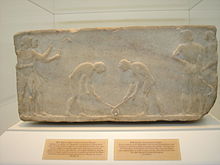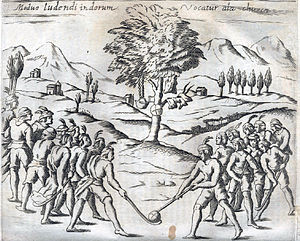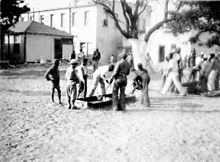Hockey
Hockey is a term used to denote a family of various types of both summer and winter team sports which originated on either an outdoor field, sheet of ice, or dry floor such as in a gymnasium.
While these sports vary in specific rules, numbers of players, apparel, and playing surface, they share broad characteristics of two opposing teams using sticks to propel a ball or disk into a goal.
The first case is a style of floor hockey whose rules were codified in 1936 during the Great Depression by Canada's Sam Jacks.
The second case involves a variant which was later modified in roughly the 1970s to make a related game that would be considered suitable for inclusion as a team sport in the newly emerging Special Olympics.
Ringette was also invented by Sam Jacks, the same Canadian who codified the rules for the open disk style of floor hockey 1936.
The first recorded use of the word hockey is in the 1773 book Juvenile Sports and Pastimes, to Which Are Prefixed, Memoirs of the Author: Including a New Mode of Infant Education by Richard Johnson (Pseud.
[1] The belief that hockey was mentioned in a 1363 proclamation by King Edward III of England[2] is based on modern translations of the proclamation, which was originally in Latin and explicitly forbade the games "Pilam Manualem, Pedivam, & Bacularem: & ad Canibucam & Gallorum Pugnam".
[7] The curved, or "hooked" ends of the sticks used for hockey would indeed have resembled these staves, and similar folk etymologies exist for the bat-and-ball sports of Croquet and Cricket.
However, the "hockey" referred to in common parlance often depends on locale, geography, and the size and popularity of the sport involved.
In Egypt, 4000-year-old carvings feature teams with sticks and a projectile, hurling dates to before 1272 BC in Ireland, and there is a depiction from approximately 600 BC in Ancient Greece, where the game may have been called kerētízein (κερητίζειν) because it was played with a horn or horn-like stick (kéras, κέρας).
[11] In Inner Mongolia, the Daur people have been playing beikou, a game similar to modern field hockey, for about 1,000 years.
[15]By the 19th century, the various forms and divisions of historic games began to differentiate and coalesce into the individual sports defined today.
Field hockey is played on gravel, natural grass, or sand-based or water-based artificial turf, with a small, hard ball approximately 73 mm (2.9 in) in diameter.
The game is popular among both men and women in many parts of the world, particularly in Europe, Asia, Australia, New Zealand, South Africa, and Argentina.
Modern field hockey sticks are constructed of a composite of wood, glass fibre or carbon fibre (sometimes both) and are J-shaped, with a curved hook at the playing end, a flat surface on the playing side and a curved surface on the rear side.
It is similar to the outdoor game in that two teams compete to move a hard ball into the goal of the opposing side using hockey sticks.
The first organized and recorded game of ice hockey was played indoors in Montreal, Quebec, Canada, on March 3, 1875, and featured several McGill University students.
Inline sledge hockey is being developed to allow everyone, regardless of whether they have a disability or not, to complete up to world championship level based solely on talent and ability[26].
[citation needed] The first game of organized inline sledge hockey was played at Bisley, Surrey, England, on December 19, 2009, between the Hull Stingrays and the Grimsby Redwings.
Matt Lloyd is credited with inventing inline sledge hockey, and Great Britain is seen as the international leader in the game's development.






